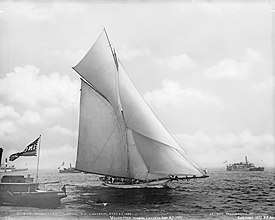Volunteer (yacht)
Volunteer was an American racing yacht built in 1887 for the America's Cup races. She was the victorious American defender of the seventh America's Cup match that same year against Scottish challenger Thistle.
 Volunteer turning Sandy Hook Lightship during the America's Cup race on September 27, 1887 | |
| Yacht club | |
|---|---|
| Nation | |
| Designer(s) | Edward Burgess |
| Builder | Pusey & Jones Shipbuilding Company |
| Launched | 1887 |
| Owner(s) | General Charles J. Paine |
| Fate | Broken up in 1910 |
| Racing career | |
| Skippers | Hank Haff |
| Notable victories |
|
| America's Cup | 1887 |
| Specifications | |
| Displacement | 130 tons |
| Length |
|
| Beam | 23 ft 2 in (7.06 m) |
| Draft | 10 ft 0 in (3.05 m) |
| Sail area | 8,981 sq ft (834.4 m2) |
Design
Volunteer, a centerboard compromise sloop, was designed by Edward Burgess and built by Pusey & Jones Shipbuilding Company at Wilmington, Delaware in 1887 for owner General Charles J. Paine of the New York Yacht Club.
Volunteer was the first America's Cup yacht with an all steel frame and hull. Her deck was made of white pine.
Career
Volunteer easily beat the 1886 America's Cup defender Mayflower during the defender trials for the 1887 America's Cup and won both Cup races on September 27 and 30, 1887, against Thistle. Volunteer was skippered by Captain Hank Haff with the assistance of Captains Terry, Berry and L. Jeffreys.
Soon after the Cup races, Volunteer was bought by John Malcolm Forbes (who also owned Puritan) and was Re-rigged as a schooner in 1891.

On August 21,1893 she went onto the rocks at Hadley's Harbor, Naushon Island, off the coast of Massachusetts.[1] Damage was extensive, as shown in the picture below. In 1894, in anticipation of racing with the British Valkyrie, she was returned to her original sloop rig.[2] She was broken up at a New York junkyard in 1910.
References and external links
| Wikimedia Commons has media related to Volunteer (ship, 1887). |
- "Volunteer on the Rocks". New York Times. August 22, 1893.
- "Good Yacht Races Promised". New York Times. February 4, 1894.